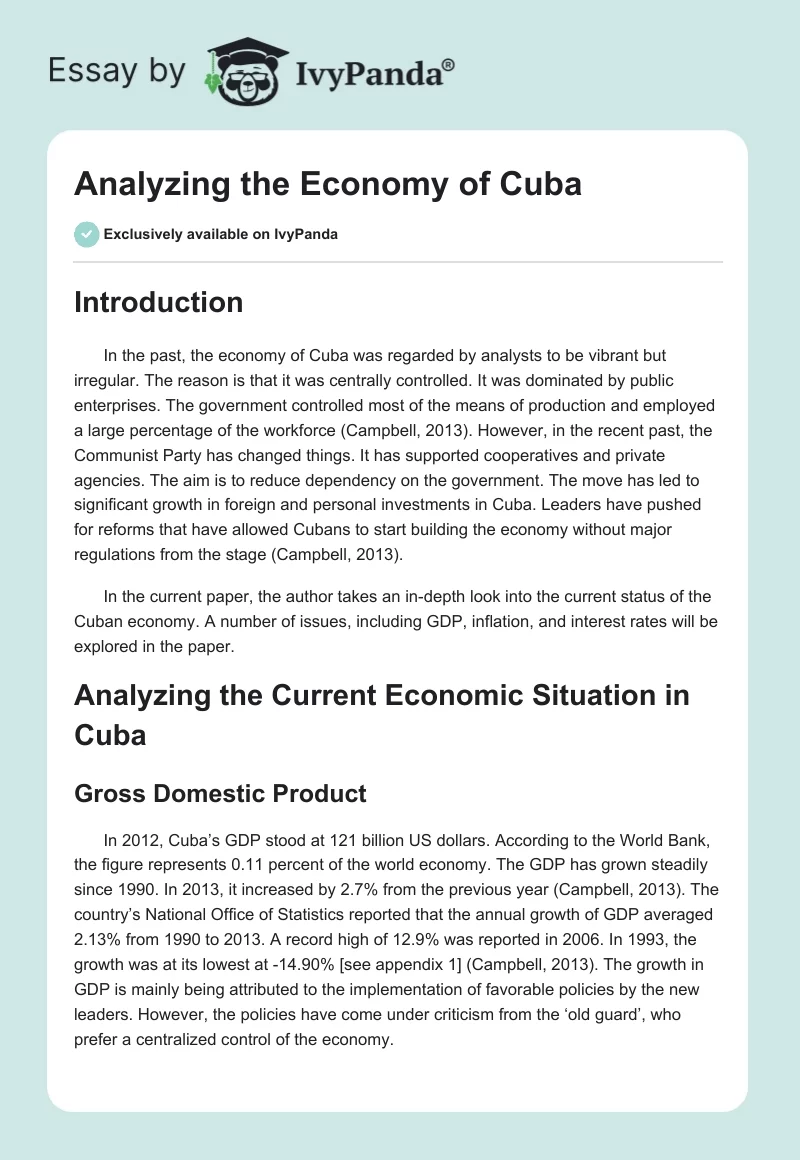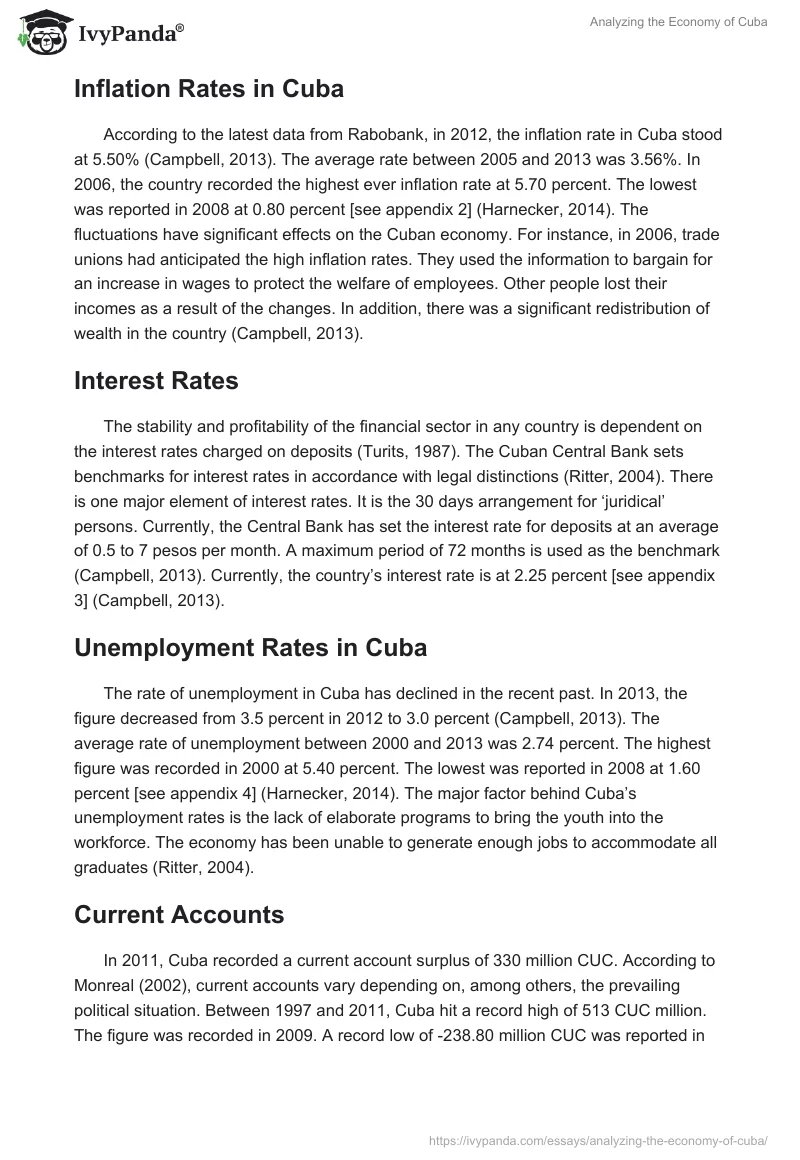Introduction
In the past, the economy of Cuba was regarded by analysts to be vibrant but irregular. The reason is that it was centrally controlled. It was dominated by public enterprises. The government controlled most of the means of production and employed a large percentage of the workforce (Campbell, 2013). However, in the recent past, the Communist Party has changed things. It has supported cooperatives and private agencies. The aim is to reduce dependency on the government. The move has led to significant growth in foreign and personal investments in Cuba. Leaders have pushed for reforms that have allowed Cubans to start building the economy without major regulations from the stage (Campbell, 2013).
In the current paper, the author takes an in-depth look into the current status of the Cuban economy. A number of issues, including GDP, inflation, and interest rates will be explored in the paper.
Analyzing the Current Economic Situation in Cuba
Gross Domestic Product
In 2012, Cuba’s GDP stood at 121 billion US dollars. According to the World Bank, the figure represents 0.11 percent of the world economy. The GDP has grown steadily since 1990. In 2013, it increased by 2.7% from the previous year (Campbell, 2013). The country’s National Office of Statistics reported that the annual growth of GDP averaged 2.13% from 1990 to 2013. A record high of 12.9% was reported in 2006. In 1993, the growth was at its lowest at -14.90% (Campbell, 2013). The growth in GDP is mainly being attributed to the implementation of favorable policies by the new leaders. However, the policies have come under criticism from the ‘old guard’, who prefer a centralized control of the economy.
Inflation Rates in Cuba
According to the latest data from Rabobank, in 2012, the inflation rate in Cuba stood at 5.50% (Campbell, 2013). The average rate between 2005 and 2013 was 3.56%. In 2006, the country recorded the highest ever inflation rate at 5.70 percent. The lowest was reported in 2008 at 0.80 percent (Harnecker, 2014). The fluctuations have significant effects on the Cuban economy. For instance, in 2006, trade unions had anticipated the high inflation rates. They used the information to bargain for an increase in wages to protect the welfare of employees. Other people lost their incomes as a result of the changes. In addition, there was a significant redistribution of wealth in the country (Campbell, 2013).
Interest Rates
The stability and profitability of the financial sector in any country is dependent on the interest rates charged on deposits (Turits, 1987). The Cuban Central Bank sets benchmarks for interest rates in accordance with legal distinctions (Ritter, 2004). There is one major element of interest rates. It is the 30 days arrangement for ‘juridical’ persons. Currently, the Central Bank has set the interest rate for deposits at an average of 0.5 to 7 pesos per month. A maximum period of 72 months is used as the benchmark (Campbell, 2013). Currently, the country’s interest rate is at 2.25 percent (Campbell, 2013).
Unemployment Rates in Cuba
The rate of unemployment in Cuba has declined in the recent past. In 2013, the figure decreased from 3.5 percent in 2012 to 3.0 percent (Campbell, 2013). The average rate of unemployment between 2000 and 2013 was 2.74 percent. The highest figure was recorded in 2000 at 5.40 percent. The lowest was reported in 2008 at 1.60 percent (Harnecker, 2014). The major factor behind Cuba’s unemployment rates is the lack of elaborate programs to bring the youth into the workforce. The economy has been unable to generate enough jobs to accommodate all graduates (Ritter, 2004).
Current Accounts
In 2011, Cuba recorded a current account surplus of 330 million CUC. According to Monreal (2002), current accounts vary depending on, among others, the prevailing political situation. Between 1997 and 2011, Cuba hit a record high of 513 CUC million. The figure was recorded in 2009. A record low of -238.80 million CUC was reported in 2008 (Harnecker, 2014). Reports on current accounts in Cuba are provided by the National Office of Statistics.
Balance of Trade
In 2013, Cuba recorded a trade deficit of 9190.30 million CUC. The average figure between 1990 and 2013 was -4019.75 million CUC (Harnecker, 2014). Cuba has a relatively consistent trade deficit mainly because of the economy’s low productivity (Monreal, 2002). The country largely depends on imports to feed the population. Another reason why Cuba has problems with the balance of trade is the use of inappropriate trade policies in the past (Whitfield, 2008). The developments often lead to crises even in the face of strong preventive measures. For example, in 2008, the value of the Cuban currency depreciated. As a result, the country faced difficulties in conducting international trade. Foreign products became expensive due to the weak currency (Campbell, 2013).
International Trade in Cuba
The Cuban economy is largely dependent on imports (Ritter, 2004). The country has established trade relations with many nations around the world, especially those in Latin America, Europe, Asia, the Caribbean, and Africa. Other major trading partners include Venezuela, the Netherlands, the US, and Russia (Ritter, 2004). Cuba has been forced to re-establish broken relations with former trading partners so as to thrive economically. For instance, the sudden severance of trade ties with Russia and the Eastern bloc wrecked havoc on the Cuban economy (Harnecker, 2014). The government had to re-establish the ties to survive economically. The incident was a turning point for Cuba. It was during this period that the country diversified its trading partners.
Cuba exports a wide range of products. They include metallic ores, fish, nickel, sugar, honey, and thyroid extracts. Others are cement, cigars, fuel, and beverages. Sugar is the major commodity in the country’s export market (Campbell, 2013). Together with honey, this product accounts for 53% of the country’s export trade (Monreal, 2002). Other significant contributors to the country’s export trade include nickel (23%), fish (6.8%), tobacco (5.6), and medicinal drugs [2.8%] (Campbell, 2013). Russia is the biggest buyer of Cuba’s exports at 27%. Spain accounts for 17%, while Canada takes up 9%. Cuba imports a wide variety of products. They include petroleum, food, machinery, and chemicals. Majority of the imports are from Spain (17%), France (9%), and Canada (8%) (Harnecker, 2014).
Cuba uses the Cuban Peso as the medium of exchange in international trade (Whitfield, 2008). Currency rankings show that CUP: USD is the most preferred exchange rate among Cuban traders (Whitfield, 2008). The peso is fairly strong. However, embargos and other regulations have impacted negatively on this strength. It has remained strong against other currencies (Harnecker, 2014).
Conclusion
Cuba is a relatively strong economy from which other countries can learn from. A number of factors affect the country’s economic terrain. The various elements of Cuban economy give it a competitive advantage or disadvantage over other countries in the world. The growth of the Cuban economy shows that it is important for a country to involve itself in international trade and to diversify its trading partners in the global market. Cuba was dealt a major blow when the Soviet Union, which was a major trading partner at one time, severed its links with the country.
References
Campbell, A. (2013). Cuban economists on the Cuban economy. Gainesville: University Press of Florida.
Harnecker, C. (2014). Non-state enterprises in Cuba: Building socialism?. Latin American Perspectives, 41(4), 113-128.
Monreal, P. (2002). Development prospects in Cuba: An agenda in the making. London: Institute of Latin American Studies.
Ritter, A. (2004). The Cuban economy. Pittsburgh: University of Pittsburgh Press.
Turits, R. (1987). Trade, debt, and the Cuban economy. World Development, 15(1), 163-180.
Whitfield, E. (2008). Cuban currency. Minneapolis: University of Minnesota Press.


